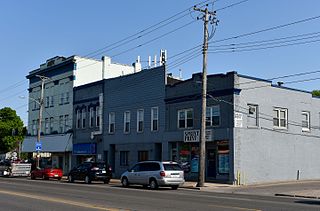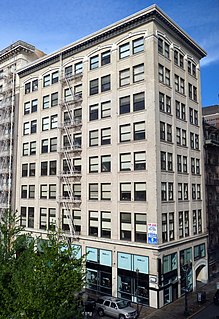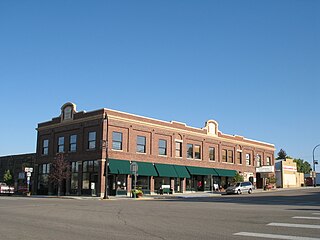
Huntington is a city in Cabell and Wayne counties in the U.S. state of West Virginia. It is the county seat of Cabell County, and the largest city in the Huntington-Ashland, WV-KY-OH Metropolitan Statistical Area, sometimes referred to as the Tri-State Area. A historic and bustling city of commerce and heavy industry, Huntington has benefited from its location on the Ohio River at the mouth of the Guyandotte River. It is home to the Port of Huntington Tri-State, the second-busiest inland port in the United States.

The Financial District of Lower Manhattan, also known as FiDi, is a neighborhood located on the southern tip of Manhattan island in New York City. It is bounded by the West Side Highway on the west, Chambers Street and City Hall Park on the north, Brooklyn Bridge on the northeast, the East River to the southeast, and South Ferry and the Battery on the south.

The Marquette Building, completed in 1895, is a Chicago landmark that was built by the George A. Fuller Company and designed by architects Holabird & Roche. The building is currently owned by the John D. and Catherine T. MacArthur Foundation. It is located in the community area known as the "Loop" in Cook County, Illinois, United States.

The Madam C. J. Walker Building, which houses the Madam Walker Legacy Center, was built in 1927 in the city of Indianapolis, in the U.S. state of Indiana, and as Madam C. J. Walker Manufacturing Company, it was designated a National Historic Landmark in 1991. The four-story, multi-purpose Walker Building was named in honor of Madam C. J. Walker, the African American hair care and beauty products entrepreneur who founded the Madam C. J. Walker Manufacturing Company, and designed by the Indianapolis architectural firm of Rubush & Hunter. The building served as the world headquarters for Walker's company, as well as entertainment, business, and commercial hub along Indiana Avenue for the city's African American community from the 1920s to the 1950s. The historic gathering place and venue for community events and arts and cultural programs were saved from demolition in the 1970s. The restored building, which includes African, Egyptian, and Moorish designs, is one of the few remaining African-Art Deco buildings in the United States. The Walker Building was added to the National Register of Historic Places in 1980.

The Emil Bach House is a Prairie style house in the Rogers Park neighborhood of Chicago, Illinois, United States that was designed by architect Frank Lloyd Wright. The house was built in 1915 for an admirer of Wright's work, Emil Bach, the co-owner of the Bach Brick Company. The house is representative of Wright's late Prairie style and is an expression of his creativity from a period just before his work shifted stylistic focus. The Bach House was declared a Chicago Landmark on September 28, 1977, and was added to the U.S. National Register of Historic Places on January 23, 1979.

The Bank of California Building, also known as the Durham & Bates Building and currently the Three Kings Building, is a historic former bank building in downtown Portland, Oregon, United States. It has been on the National Register of Historic Places since 1978. The three-story building was designed by A. E. Doyle in an Italianate style and completed in 1925. The ground floor features a two-story-high grand room with 36-foot (11 m) ceilings. The building's original owner and occupant, the Bank of California, moved out around the end of 1969 and sold the building in 1970. It has had a succession of other owners and tenants since then. It was last used as a bank in 1977.

The Marshall Field and Company Building, which now houses Macy's State Street in Chicago, Illinois, was built in two stages—north end in 1901–02 and south end in 1905–06, and was the flagship location of the Marshall Field and Company and Marshall Field's chain of department stores. Since 2006, it is the main Chicago mid-western location of the Macy's department stores. The building is located in the Chicago "Loop" area of the downtown central business district in Cook County, Illinois, U.S.A., and it takes up the entire city block bounded clockwise from the west by North State Street, East Randolph Street, North Wabash Avenue, and East Washington Street.

The F. W. Woolworth Company Building is a historic department store building located in downtown Wilmington, Delaware.

There are nine historic districts in Meridian, Mississippi. Each of these districts is listed on the National Register of Historic Places. One district, Meridian Downtown Historic District, is a combination of two older districts, Meridian Urban Center Historic District and Union Station Historic District. Many architectural styles are present in the districts, most from the late 19th century and early 20th century, including Queen Anne, Colonial Revival, Italianate, Art Deco, Late Victorian, and Bungalow.

The Nathaniel West Buildings in southeast Portland, Oregon, United States, are listed on the National Register of Historic Places. The two structures are part of a group of three, including West's Block, built by West in the late 19th century.

The Hines Mansion is a historic house in Provo, Utah, United States. It is listed on the National Register of Historic Places. It was built in 1895 for R. Spencer Hines and his wife Kitty. At the time the mansion was built, it was recognized as one of the finest homes in Provo. The Hines Mansion was designated to the Provo City Historic Landmarks Registry on March 7, 1996.

The College Corner Commercial Historic Business District, also known as the Highland Park Historic Business District at Euclid and Second, is located in the north-central section of Des Moines, Iowa, United States. It is located in the Highland Park neighborhood that also includes the Highland Park Historic Business District at Euclid and Sixth Avenues. The College Corner historic district has been listed on the National Register of Historic Places since 1998.

Standard Drug Company is a historic pharmaceutical company in Meridian, Mississippi. Originally established as a small retail drug store in 1900, the company was incorporated in 1919 and became one of the largest commercial firms in the city. The building was listed on the National Register of Historic Places in 1989.

The Durlin Hotel, which was renamed the Oatman Hotel, is located on Main St. in Oatman, Arizona, United States. It was built in 1924 by John Durlin and includes Spanish Colonial Revival architecture.

The Woodlark Building is a historic commercial building in downtown Portland, Oregon, United States that is listed on the National Register of Historic Places. The nine-story building was designed by Doyle, Patterson & Beach, and constructed in 1911–12. It has been described as "one of Portland's earliest commercial skyscrapers". From its completion until 1924, it was the headquarters of two jointly owned and very similarly named pharmaceutical companies based in Portland, the retail Woodard, Clarke & Company, and the wholesale Clarke-Woodward Company. It was converted into an office building in 1924. The retail space on the ground floor, mezzanine and basement has held a variety of businesses, in succession over the building's history, among the longest-lasting ones being a drugstore (1912–1927), a Sherman Clay piano and music store (1930–1974), and an independent shoe store (2000–2016).

The Ayers Bank Building is a historic bank building located at 200 West State Street in Jacksonville, Illinois. This site is believed to have been continuously associated with banking since 1832, longer than any other site in Illinois.

Commerce Block is a commercial building in Glenrock, Wyoming, built in 1917 during the Wyoming oil boom of the early 20th century. The nearby Big Muddy oil field brought prosperity to Glenrock, stimulating the growth of the town's commercial district. The building was built for the Glenrock Investment Company, a consortium of local investors, by Edward R. Reavill. The building housed the Glenrock State Bank until 1934. Other businesses in the building included a bar, a billiard parlor and a drug store. The Empress Theater took a two-story space in the east wing of the block. By the late 1920s the oil boom had ended and the theater passed through several owners, closing intermittently. In 1939 it was renamed the Wyoma Theater and had a prominent marquee.

The C.H. King Company and First National Bank Building, also known as Yellowstone Drug, is one of the oldest buildings in Shoshoni, Wyoming. The building was built for Charles Henry King in 1905–1906. King was a central Wyoming businessman who established a lumber business in the building. King is otherwise notable as the biological grandfather of U.S. president Gerald R. Ford. The First National Bank of Shoshoni was also located in the building.

The Hawthorne Glove and Novelty Company–Shrader Drug Company Building is a historic building located in Iowa City, Iowa, United States. Completed in 1906, this utilitarian three-story brick structure is located in the city's original railroad and industrial corridor south of the central business district. This was an industrial area from the 1870s to the 1940s. It replaced a recently built building on the same site by the Hawthorne Glove and Novelty Company that had been destroyed in a fire. The back of the building opened upon the rail sidings of a branch line of the Burlington, Cedar Rapids and Northern Railway, later the Chicago, Rock Island and Pacific. By the start of World War I the Shrader Drug Company occupied the building. It was one of three drug related factories that were located along the South Gilbert Street corridor at that time. The company name changed to the Hewell-Shrader Drug Company in 1930 and then the Hewell-Shrader Company in 1945 after farm fertilizer was added to its product line. The company closed in 1956, and the building was sold to the Thompson Transfer and Storage Company who used it for a warehouse. Whipple House Furniture Store took over the building three years later, and remained until 1975. In the intervening years a variety of businesses occupied the building until the 1980s when it was vacant for a period of time. In the mid-1980s The Vine Tavern occupied the basement level and the upper floors were used for artist studios. In 2012 the upper floors were converted into apartments. The building was listed on the National Register of Historic Places in 2014.





















